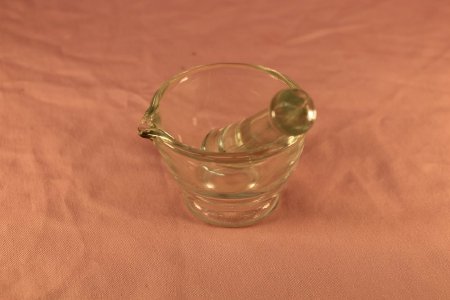Object ID Number:
PH305
Object Name:
Mortar & Pestle
Type:
Glass Mortar & Pestle
Manufactured from:
1850
Manufactured to:
1900
Description / History:
Small glass mid 19th century mortar and pestle. It is made from machine blown clear glass. The top of the mortar has a pouring spout molded into it. Molded into the bottom of the mortar reads 2 OZ MADE IN US. The pestle has a number 2 molded into the side near the top.
Donated to EHMHF by William K. Moore, DDS
Donated to EHMHF by William K. Moore, DDS
Dimensions:
H–2.5 Dia–3.25 inches
Additional Information:
Mortars and pestles were traditionally used in pharmacies to crush various ingredients prior to preparing an extemporaneous prescription. The mortar and pestle,with the Rod of Asclepius, the Orange Cross, and others, is one of the most pervasive symbols of pharmacology, along with the show globe.
For pharmaceutical use, the mortar and the head of the pestle are usually made of porcelain, while the handle of the pestle is made of wood. This is known as a Wedgwood mortar and pestle and originated in 1779. Later, marble and glass were also used. Today the act of mixing ingredients or reducing the particle size is known as trituration.
Mortars and pestles are also used as drug paraphernalia to grind up pills to speed up absorption when they are ingested, or in preparation for insufflation.
For pharmaceutical use, the mortar and the head of the pestle are usually made of porcelain, while the handle of the pestle is made of wood. This is known as a Wedgwood mortar and pestle and originated in 1779. Later, marble and glass were also used. Today the act of mixing ingredients or reducing the particle size is known as trituration.
Mortars and pestles are also used as drug paraphernalia to grind up pills to speed up absorption when they are ingested, or in preparation for insufflation.
